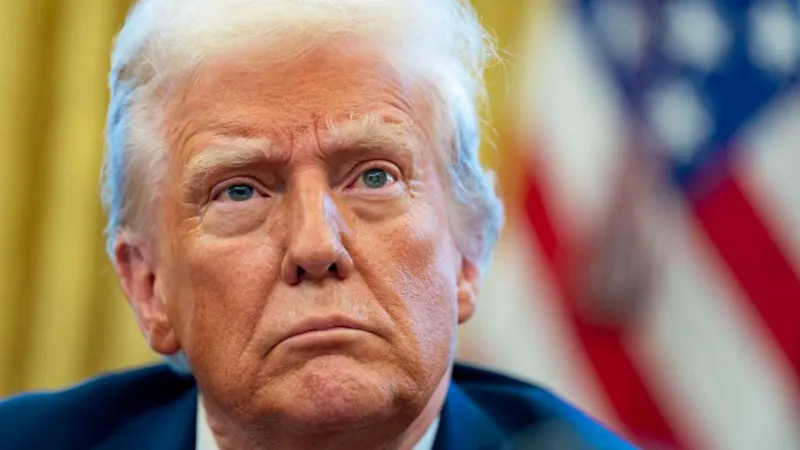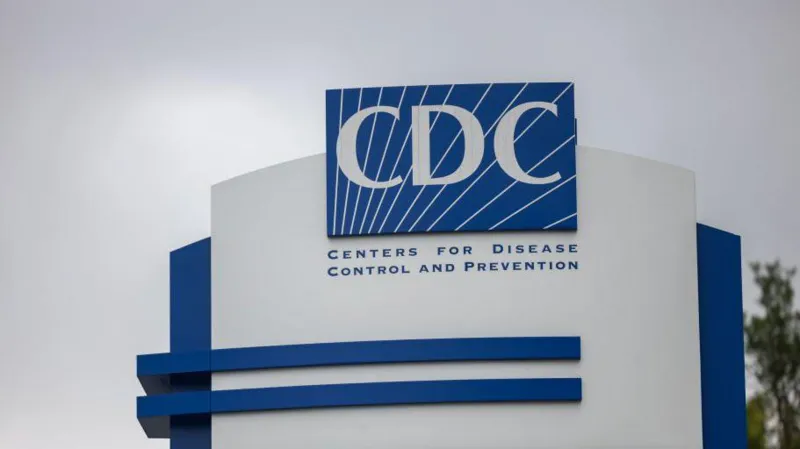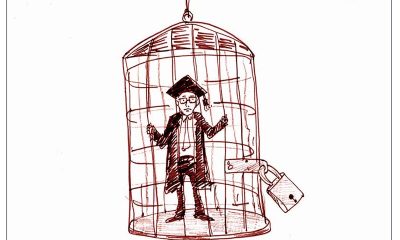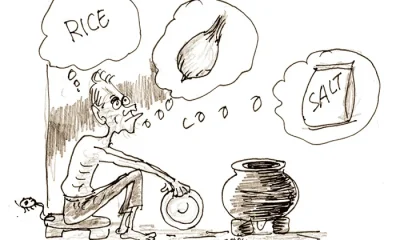Latest News
Spirited South Africa look to end mighty India’s dominance in final clash

Two unbeaten sides. Two stories of significant progress over two years will culminate with the final of the Under 19 Women’s T20 World Cup in Kuala Lumpur today.
It might only be edition number two, but India have asserted themselves as the team to beat in this competition. They have outclassed every team in their path to the finals, and have looked stronger than the title-winning squad in 2023 with two capped internationals under Shafali Verma.
Niki Prasad’s team has exhibited skills that might well mistake them for being a senior side, be it ball striking and power hitting with bat, accuracy and discipline with ball or athleticism and catching efficiency in the field. West Indies, Malaysia, Scotland and Bangladesh were brushed aside without sweat. Sri Lanka (in the group stage) and England (in the semi-finals) had their moments, but were unable to press the advantage across 40 overs, and India eventually prevailed comfortably.
India’s pathway to prepare for the tournament also trumps most sides, many of whom had never travelled overseas before the World Cup. They won the U-19 Women’s Asia Cup in December 2024, with all games played at the Bayumeas Oval in Kuala Lumpur, the venue for each of India’s World Cup fixtures as well as the semi-final and final. Prior to that, two Under-19 sides played a triangular series in Pune that also featured South Africa, their opponents for the final.
That South Africa’s story in World Cups has moved from falling short of finals to falling short in finals might be considered progress in itself.
Under captain Kayla Reyneke one of seven players in the squad playing in their second edition, South Africa have shown significant progress after failing to go beyond the Super Six at home in 2023. They outclassed Australia in Friday’s semi-final which was effectively their first experience of a full game in the tournament. Their previous wins were secured in severely reduced games, largely due to rain against New Zealand, Nigeria and Ireland, and Samoa’s 16 all out. Still they got the job done emphatically.
After two consecutive senior women’s T20 World Cup final appearances in as many years, and just as many heartbreaks, South Africa have set their sights on the Under-19 women’s team to bring home a first women’s title, just as India did in 2023.
Power-hitting takes time to evolve. It’s unlikely to be seen at the women’s Under-19 level. Try telling G Trisha and Jemma Botha that. Both, in their second edition of the tournament, are now promoted to open the batting. They both also have the power game that could decide the fate of the final.
Trisha is the tournament’s leading run-scorer and is likely to remain so regardless of what happens in the final after striking the first hundred in the competition, against Scotland. It’s not just the 265 runs though, it’s the strike rate of 149.71 that stands out.
Botha might have been competing for similar honours had South Africa’s batters batted more than the 26.5 overs they did in the entire tournament leading up to the semi-final. Her 37 off 24 with five fours and two sixes at a strike rate of 154 in the semi-final against Australia gave South Africa a crucial head start that proved to be decisive in what could have been a tricky chase.
Both teams are likely to stick with the same XIs from their respective semi-finals.
India (probable): G Trisha, G Kamalini (wk), Sanika Chalke, Nikki Prasad (capt), Ishwari Awasare, Mithila Vinod, Aayushi Shukla, VJ Joshitha, Shabnam Shakil, Parunika Sisodia, Vaishnavi Sharma
South Africa (probable): Jemma Botha, Simone Lourens, Kayla Reyneke (capt), Karabo Meso (wk), Fay Cowling, Mieke van Voorst, Seshnie Naidu, Luyanda Nzuza, Ashleigh van Wyk, Monalisa Legodi, Nthabiseng Nini
[Cricinfo]
Foreign News
Trump imposes tariffs but Canada and Mexico hit back

US President Donald Trump has announced sweeping new tariffs on all goods imported from America’s three largest trading partners, China, Mexico and Canada.
Trump said the US would impose tariffs beginning on Tuesday of 25% on Canada and Mexico, and 10% on China. Canadian energy faces a lower 10% tariff.
He had threatened to impose the import taxes if the three countries did not address his concerns about illegal immigration and drug trafficking.
Both Canada and Mexico said they are preparing retaliatory tariffs of their own.
Trump has indicated he is ready to escalate the duties if the countries retaliate.
Together, China, Mexico and Canada accounted for more than 40% of imports into the US last year.
“Today’s tariff announcement is necessary to hold China, Mexico, and Canada accountable for their promises to halt the flood of poisonous drugs into the United States,” the White House said in a statement on X on Saturday.
Trump posted on his Truth Social platform: “This was done through the International Emergency Economic Powers Act (IEEPA) because of the major threat of illegal aliens and deadly drugs killing our Citizens, including fentanyl.”
A tariff is a domestic tax levied on goods as they enter the country, proportional to the value of the import. They are a central part of Trump’s economic vision.
He sees them as a way of growing the US economy, protecting jobs and raising tax revenue – and in this case, pushing for policy action from allies.
In her response, Mexican President Claudia Sheinbaum called allegations that the Mexican government had alliances with criminal organisations “slander”.
The White House, in its announcement, accused Mexico’s government of having “an intolerable alliance” with Mexican drug trafficking organisations.
In a statement, Sheinbaum called on the US to do more to clamp down on the illegal flow of guns south to arm the cartels.
Her country is willing to work with the US, she said. “Problems are not resolved by imposing tariffs, but by talking.”
She has instructed her economy minister to respond with tariff and non-tariff measures. They are expected to include retaliatory tariffs of 25% on US goods.
Canadian Prime Minister Justin Trudeau said his country will also respond.
“We don’t want to be here, we didn’t ask for this,” he said in a news conference late on Saturday.
“But we will not back down in standing up for Canadians.”
His government will impose 25% tariffs on $155bn worth of American goods – $30bn will come into force on Tuesday and another $125bn in 21 days.
Targeted items include American beer, wine, bourbon, fruits and fruit juices, vegetables, perfumes, clothing and shoes, as well as household appliances, sporting goods and furniture. Lumber and plastics will also face levies.
Non-tariff measures being considered are related to critical minerals and procurement, although Trudeau did not offer more detail.
The prime minister pushed back on the suggestion the shared border posed a security concern, saying less than 1% of fentanyl going into the United States comes from Canada.
In a bid to avoid the tariffs altogether, Ottawa had promised to implement C$1.3bn ($900m; £700m) of new security measures along its US border.
“Tariffs are not the best way we can work together to save lives,” Trudeau said.
He also said he had not spoken to Trump since the inauguration, but would keep lines open with US counterparts.
China said in a statement that it is strongly dissatisfied with the levies and “firmly opposes” them.
It added that it would file a lawsuit with the World Trade Organization against the US for its “wrongful practice” and would take countermeasures to “safeguard its own rights and interests”.
China’s vice-premier Ding Xuexiang told the World Economic Forum in Davos, Switzerland, last month that his country was looking for a “win-win” solution to trade tensions and wanted to expand its imports.
Canada, Mexico and the US have deeply integrated economies, with an estimated $2bn (£1.6bn) worth of manufactured goods crossing the borders daily.
Economists say the tariffs and subsequent retaliation could raise prices on a wide range of products, from cars, lumber, and steel to food like frozen French fries, avocados, and tomatoes, to alcohol.
The auto sector could be especially hard hit. Auto parts cross the three borders multiple times before a final vehicle is assembled. TD Economics suggest the average US car price could increase by around $3,000.
A January report by the Peterson Institute for International Economics suggested blanket 25% tariffs on Canada and Mexico would slow growth and accelerate inflation in all three countries.
On Friday, Trump acknowledged there could be “some temporary, short-term disruption” from the tariffs.
The Canadian Chamber of Commerce released a statement saying tariffs will have “immediate and direct consequences on Canadian and American livelihoods” and will “drastically increase the cost of everything for everyone”.
US industry groups have also raised alarm bells.
The National Homebuilders Association said the levies could increase housing costs.
The Farmers for Free Trade said, with many US farmers already struggling, “adding tariffs to the mix would only exacerbate the situation across much of rural America”.
The US Retail Industry Leaders Association, which includes big names such as Home Depot, Target and Walgreens among its more than 200 members, expressed hope tariffs could still be averted.
The White House, explaining on Saturday why it was targeting its top trading partners, said Mexican cartels were responsible for trafficking fentanyl, methamphetamine and other drugs.
It said tariffs on Canada would remain until it “co-operates with the US against drug traffickers and on border security”.
Lastly, it said “China plays the central role in the fentanyl crisis” with exports of the lethal synthetic painkiller.
Both the northern and southern US borders have reported drug seizures, though amounts at the border with Canada are considerably lower than those with Mexico, according to official data,
US border agents seized 43lbs (19.5kg) of fentanyl at the northern border between October 2023 and last September, compared to more than 21,000lbs (9,525.4kg) at the southern border.
Still, recent reports from Canadian intelligence agencies suggest a growing number of transnational organised crime groups are manufacturing drugs in Canada.
Ashley Davis, a Republican lobbyist for businesses, who represents major US companies, including Walmart and Boeing, and has been involved in discussions about tariffs, told the BBC’s World Business Report she thinks Trump will pull back on the tariffs in North America if he can point to progress on the issues he has raised as complaints – especially immigration.
“You have to remember – the border and China are the two biggest issues that Americans voted him on in the elections in November. Anything he can do to claim wins on that, I think he’s going to do,” she said.
Latest News
Dozens of soldiers, fighters killed in Baloch separatist attack in Pakistan

At least 18 paramilitary soldiers and 24 armed attackers have been killed in two related incidents in southwestern Pakistan, according to officials and local media reports, as sectarian, ethnic and separatist violence escalates in the region.
Pakistan’s military on Saturday said fighters tried to set up roadblocks overnight in the restive province of Balochistan and most of the deaths took place as security forces removed them
A vehicle “carrying unarmed Frontier Corps paramilitaries” near the town of Mangochar “came under gunfire from 70 to 80 armed assailants who had blocked the road”, a police official told the AFP news agency.
The officer said three other paramilitaries were seriously injured while two escaped unharmed.
In a statement, the Baloch Liberation Army claimed responsibility for the attack on the paramilitary, but gave a lower death toll of 17.
At least 11 of the attackers were killed in what the military described as follow-up “clearance operations” on Saturday.
Pakistan’s Prime Minister Shehbaz Sharif in a statement condemned the attack.
The mineral-rich Balochistan, which borders Iran and Afghanistan, has been the scene of a decade old rebellion by separatist ethnic Baloch groups. Several armed groups also operate there.
On Tuesday, in a separate incident, attackers in an explosive-laden vehicle were thwarted in their attempt to overrun a Pakistani security post near the border with Afghanistan.
In January, at least six people were killed in an attack also claimed by the BLA, one of the main separatist groups in the region. In November, the BLA also said it carried out coordinated attacks that killed at least 39 people, one of the highest tolls in the region.
In August, at least 73 people were killed in Balochistan when separatist fighters attacked police stations, railway lines and highways, and security forces launched retaliatory operations.
The violence also comes in the backdrop of worsening relations between Pakistan and the Taliban rulers of Afghanistan.
A similarly dramatic uptick in attacks has been witnessed elsewhere in Pakistan in recent months, including in northwestern Khyber Pakhtunkhwa province.
In 2024 alone, the military reported 383 soldiers and 925 fighters killed in various border area clashes.
[Aljazeera]
Latest News
US federal websites scrub vaccine data and LGBT references

The Trump administration has scrubbed references to LGBT health, and information on certain vaccines from federal websites, including top public health agencies.
The move follows a Wednesday memo instructing agencies to end all “programs that use taxpayer money to promote gender ideology” and disable related information from websites by Friday afternoon.
Trump has already issued executive orders that banned diversity, equity and inclusion in the government, as well as one that recognised two sexes male and female.
Asked by reporters on Friday if websites would be shut down to remove diversity-related content, he said: “If they want to scrub the websites, that’s OK with me.”
DEI (diversity, equity and inclusion) programmes aim to promote participation in workplaces by people from a range of backgrounds.
Their backers say they address historical or ongoing discrimination and under-representation of certain groups, including racial minorities, but critics argue such programmes can themselves be discriminatory.
On Saturday, leading public health agencies appeared to have culled webpages that discussed gender, sexually transmitted diseases, and LGBT health.
Several web pages for the Centers for Disease Control and Prevention (CDC) now display error messages.
The agency’s website contains a yellow banner message that reads, “CDC’s website is being modified to comply with President Trump’s Executive Orders”.
CDC webpages that previously contained such data on youth, transgender and LGBT health contained “page not found” messages on Saturday morning.
The CDC serves as a critical repository for official government health data and research.
The National Youth Risk Behavior Survey (YRBS) seems to have disappeared from its landing pages. The ongoing study focused on topics such as nutrition, mental health, physical activity, and sexual activity for high school students.
The tool used to explore the data is now offline.
A version of the page captured by the internet archive the WayBack Machine, shows the page was live as recently as mid-January.
The archived pages show that one aspect of study included children who “felt that they were ever treated badly or unfairly because they are or people think they are lesbian, gay, bisexual, transgender, or questioning”.
Another page dedicated to ‘Supporting LGBTQ+ Youth’ was also not available on Saturday morning, though the page is archived by the WayBack Machine.
A page that collated data related to ‘Health Disparities Among LGBTQ Youth’ also appears to be gone.
“Stigma, discrimination, and other factors put them at increased risk for negative health and life outcomes,” an archived version of the page states.
[BBC]
-

 Opinion6 days ago
Opinion6 days agoCost of ‘Sinhala Only’
-

 Features6 days ago
Features6 days agoA conversation that cannot be delayed
-

 Sports6 days ago
Sports6 days agoAussies brought the best out of me – Aravinda
-

 Editorial6 days ago
Editorial6 days agoOnly delivery can save govts.
-

 Features2 days ago
Features2 days agoA singular modern Lankan mentor – Part I
-

 Editorial5 days ago
Editorial5 days agoFish or cut bait
-

 Opinion5 days ago
Opinion5 days ago‘Not even congee now!’
-

 News4 days ago
News4 days agoWar crimes: Canada’s Conservative Party leader vows to ‘lead the world’ in seeking prosecutions against Sri Lankans











